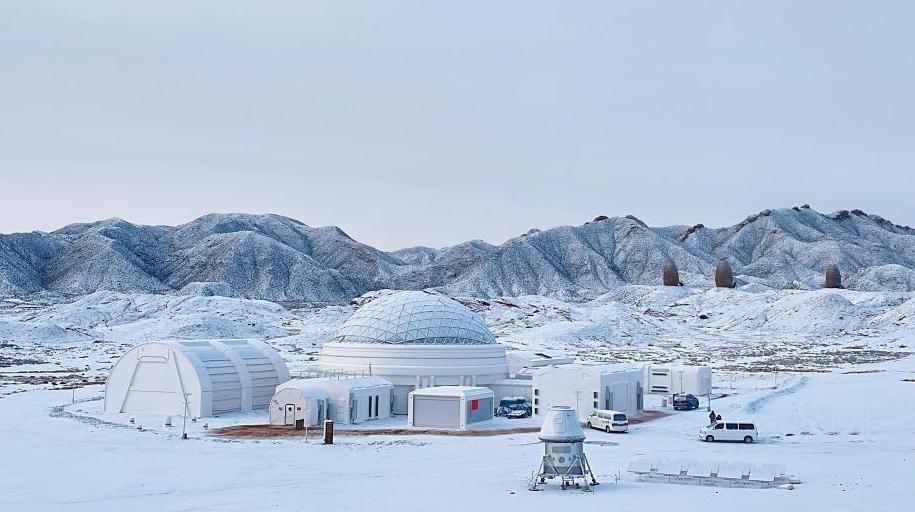Space-themed tourism takes off in Gobi Desert
 0 Comment(s)
0 Comment(s) Print
Print E-mail Xinhua, January 29, 2024
E-mail Xinhua, January 29, 2024
This photo taken on Dec. 14, 2023 shows a view of snow-covered Mars Base 1, a simulated Martian habitat, in Jinchang, northwest China's Gansu Province. (Photo by Li Ting/Xinhua)
The remote and expansive Gobi Desert in northwest China is increasingly accessible to the public, thanks to the emergence of space-themed tourism, which has opened up new frontiers for adventurous travelers.
The rocky expanse has been adorned with several white capsule-shaped structures, surrounded by gleaming solar panels and distinctive "craters" of varying sizes.
This is Mars Base 1, a simulated Martian habitat located in the city of Jinchang, Gansu Province, one of China's pivotal regions for nickel, a hard silver-white metal widely used in aerospace technology.
Resembling the Martian surface, this eroded desert landscape once served as a testing ground for Chinese scientists to evaluate various space exploration robots, including lunar rovers, Mars probes and manned spacecraft.
Now it is becoming popular among tourists too. The Chinese public's engagement in and fascination with space-related cultural activities have been on the rise in recent years, boosted by a series of space-faring achievements. After the launch of Mars probe Tianwen-1 in 2020, similar Mars simulation bases sprouted across the northwestern region, allowing visitors, particularly school-going children, to experience a slice of life on the red planet.
Participants are tasked with hiking through desert areas, searching for water resources, and pretending to be taikonauts facing life-threatening challenges. Mars-related science courses are also provided to young visitors.
Some see money-making opportunities in this passion for space, aiming to transform these desert facilities into tourist resorts. They have built space-themed hotels and restaurants, offering sleeping capsules that can accommodate up to nearly 200 people. Photos of visitors donning space suits at the base have attracted widespread media coverage.
The space-themed tourism market is substantial, as indicated by a report published by Qyer, a leading tourism website in China. It highlighted that individuals born in the 1990s and 2000s constitute over 60 percent of the overall space tourism population.
In 2023, over 80,000 visitors visited Mars Base 1. Li Fei, the head of the company's business operations, said that student groups, space enthusiasts and family tours were the primary customer segments.
In early December, 500 km away from the Mars base, 26-year-old tour guide Yang Xiaoling and her colleagues took a group of 300 students on a memorable visit. Their destination was Dongfeng Space City, also known as the Jiuquan Satellite Launch Center.
The country's only site for manned spacecraft launches, the Jiuquan Center has been listed as one of the world's top space-themed travel destinations by Lonely Planet. Facilities such as aerospace museums, launch towers and simulated taikonaut apartment compounds are among the hotspots recommended by travel guides.
The tourist season of the space city runs from July to October every year. In addition to student groups, some individual tourists book tours a day or two in advance through local travel agencies.
Yang said that the activity of watching live rocket launches is no longer exclusive to young individuals, but has become accessible to people of all ages.
Local officials are hopeful that the booming space-themed tourism industry will contribute to the improvement of local livelihoods. The government's primary focus was once on promoting traditional tourist activities, such as riding camels and climbing sand dunes. However, the local culture and tourism department has recently unveiled a comprehensive plan aimed at fostering space-themed tourism through expanding tour routes, enhancing souvenir options, and improving service provision.
In the hinterland of the Tengger Desert, China's fourth-largest desert, tourists gather around telescopes to marvel at the breathtaking beauty of the starry sky. This exceptional stargazing destination in Gansu's Minqin County has been transformed into a desert-themed town dedicated to scientific research and observation, as well as promoting the science of astronomy and related tourism. It has been nicknamed "Star Picking Town."
Since its establishment in 2020, the town has generated more than 10 million yuan (about 1.39 million U.S. dollars) in tourism revenue, showing the immense growth potential of the "space + tourism" industry.
Such projects have garnered recognition from industry experts. According to Liu Yufei, a commercial space industry insider, the conventional perception of space-themed tourism, limited to rocket models and toys, impedes its ability to cultivate a consistent customer base, thereby obstructing the mass market potential of aerospace cultural tourism.
"The creation of space-themed towns and parks, however, can offer tourists a brand-new and awe-inspiring experience they have never had before," said Liu.
She emphasized that, despite more than 600 astronauts having been launched into space, the aspiration for space exploration is shared by a global population of 8 billion individuals.
"These facilities have the potential to naturally transform into a prominent exhibition and sales platform for space-related merchandise, thereby facilitating the widespread adoption of high-tech products and generating enhanced economic benefits," Liu added.






Go to Forum >>0 Comment(s)